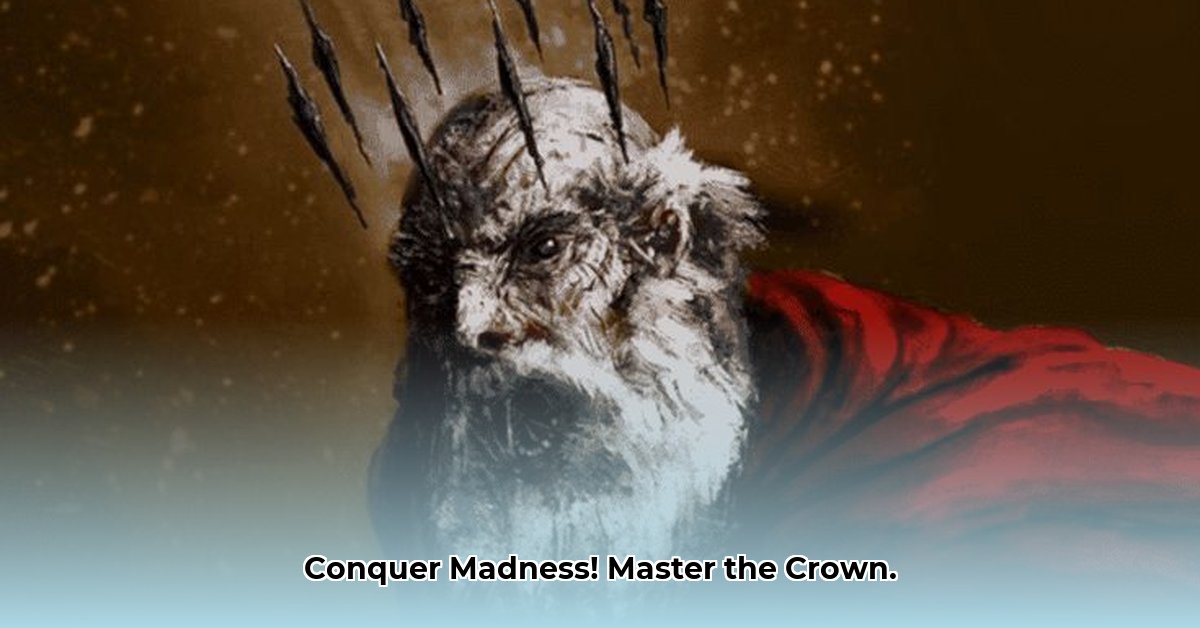Want to inject calculated chaos into your D&D 5e battles? The Crown of Madness spell is your gateway to turning enemies against each other. This instructional guide provides a comprehensive overview of this 2nd-level enchantment, designed to help players of all experience levels wield it effectively. From target selection to advanced tactics, we’ll explore how to maximize its impact and avoid common pitfalls. For more detailed strategies, check out this helpful guide: Crown of Madness Guide. Prepare to command the battlefield!
Crown of Madness 5e: Unleashing Madness and Mayhem
Let’s explore the potential of the Crown of Madness 5e spell. This chaotic enchantment can significantly shift the momentum of combat when implemented with precision and foresight. Consider it a powerful weapon, but one that demands a strategic mind to wield effectively. This guide will equip you with the knowledge to master this spell and unleash its full, mayhem-inducing potential.
Understanding the Spell’s Mechanics: A Foundation for Tactical Application
The Crown of Madness, a 2nd-level enchantment spell, focuses on creating controlled chaos. Targeting one humanoid enemy within a 120-foot radius, you force them to make a Wisdom saving throw. Upon failure, they become charmed by you for up to a minute, or until your concentration breaks. A twisted crown of jagged iron manifests upon their head, and a madness gleams in their eyes.
Here’s the core mechanic: the charmed target must use its action before moving on each of its turns to make a melee attack against a creature other than itself that you mentally choose. If you choose no creature, or if no creature is within its reach, the target can act normally. On your subsequent turns, you must use your action to maintain control, or the spell ends. The target can also attempt a Wisdom saving throw at the end of each of its turns to break free. Even if the foe has multiple attacks, they only make one melee attack against your chosen target via the spell.
Choosing Your Target: The Art of Intelligent Madness
Target selection goes beyond simply picking the largest threat. Strategy triumphs over brute force. Focus on enemies who are clustered near each other, or those who possess abilities that could severely disadvantage their allies if turned against them.
Consider a nimble rogue attacking your party’s mage. Turning the rogue against their own party could disrupt their formation and expose them to further attacks. Could a charmed goblin accidentally trigger a trap? The best targets aren’t always obvious. Look for opportunities to maximize chaos and disruption. Targets with low Wisdom scores are, naturally, ideal.
Positioning for Success: Orchestrating Chaotic Victory
Your positioning is as critical as your target. The 120-foot range offers flexibility, but consider line of sight and potential cover. Place yourself and your allies strategically so that your charmed enemy attacks where it benefits you most or causes the least harm to your party. Use cover to protect against stray attacks or attempts to break your concentration. It’s about maneuvering the entire battlefield.
Synergies and Strategies: Amplifying the Madness Through Combinations
Don’t view Crown of Madness in isolation. Combine it with other spells and class features for maximum effect. Spells that inflict the Restrained condition, like Hold Person or Web, can keep the target in place, ensuring they can only attack those within reach.
Consider spells that impose disadvantage on Wisdom saving throws, such as Bane. A bard’s Bardic Inspiration can also be used on an ally to bolster their saving throws if they become the target of the charmed creature, mitigating potential damage. Don’t forget class features like the Divination Wizard’s Portent, which can force a low roll on the enemy’s saving throw. The creative possibilities are endless.
Counterplay and Mitigation: Preparing for the Unexpected
Enemies won’t simply allow you to control them. Expect them to attempt to free their charmed comrade, disrupt your concentration, or exploit the spell’s limitations. Always have backup plans.
What happens if your target succeeds on their saving throw, or if you lose concentration? The spell’s chaotic nature means you’re never fully in control. Consider defensive spells like Shield or Counterspell to protect yourself and maintain control of the battlefield. Have allies ready to intercede if the charmed creature breaks free or turns against them.
Common Mistakes: Avoiding the Pitfalls of Imprudence
Failing to anticipate countermeasures, targeting the wrong enemy, neglecting optimal positioning, and not understanding the implications of losing concentration are common pitfalls. Remember, intelligent application is key. A haphazardly charmed foe could benefit your enemies.
Avoid casting Crown of Madness on isolated targets, or those who pose little threat to their allies. Choose targets who are likely to deal significant damage and sow chaos within their own ranks. Be mindful of your concentration. Protect yourself from damage and be prepared to re-establish control if the spell ends prematurely.
Crown of Madness 5e: Weighing the Pros and Cons
| Pros | Cons |
|---|---|
| Battlefield control potential | Relies on successful saving throws |
| Turns enemies against each other | Requires concentration, vulnerable to disruption |
| Accessible to multiple spellcasting classes | Action economy cost |
| Potential for strategic use, maximizing chaos | Only effective against humanoids |
| Excellent distraction and diversionary maneuver | Limited duration |
Mastering the Madness: A Final Word of Strategic Wisdom
The Crown of Madness rewards creative thinking and skillful planning. Practice and understanding its limitations are vital. Don’t just cast it; strategically employ it. Through experience, you’ll unlock the spell’s true potential and dominate the battlefield. Embrace the madness, but always remain in control of your strategy.
Mastering the Crown of Madness: Defensive Strategies from D&D 5e
Key Insights:
- Crown of Madness is highly situational, with target selection and battlefield awareness being crucial for casters, but equally important to understand for those defending against it.
- Understanding mechanics (range, duration, saves) helps both users and those defending against it.
- Intelligent, ranged enemies are less affected, making them often better targets for other control spells.
- Counter-strategies involve disrupting the caster, aiding the target, and exploiting the spell’s limitations.
Understanding the Crown of Madness: A Two-Sided Coin
The Crown of Madness charm forces a creature to attack as you command. However, there are nuances. The target only makes one melee attack, regardless of its normal attack count. The spell ends if the target succeeds on a Wisdom saving throw at the end of its turn, or if the caster loses concentration. Also, only humanoids are affected. Understanding these limitations is key to both using and defending against the spell.
Strategic Target Selection: Knowing Your Enemy and Yourself
Targeting a low-intelligence, melee-focused creature increases your chance of success as a caster. As a defender, recognizing this preference allows you to anticipate the caster’s moves and potentially protect vulnerable targets. A high-intelligence foe will resist, and ranged attackers are less likely to be effective under the spell’s control. Consider the target’s Armor Class (AC) and damage potential. Will they attack the nearest allies, or a greater threat? A high HP creature turned against a powerful enemy can inflict significant damage.
Countering the Crown: Defensive Strategies in Action
How to counter Crown of Madness dnd 5e involves preemptive action and reactive measures. Create distance if a caster is about to use this spell. Ranged attacks are safer since the charmed creature must move into melee range. Misty Step offers immediate escape. Protective spells such as Shield, Bless, or Protection from Evil and Good can bolster defenses and saving throws. Counterspell, of course, remains a powerful option to negate the spell entirely.
Exploiting the Spell’s Weaknesses: Turning Madness on Itself
The reliance on a single Wisdom save at the end of each turn is Crown of Madness’s primary weakness. Boosting the target’s Wisdom saving throws via spells and abilities can significantly increase their chances of breaking free. The caster needs concentration, making them vulnerable to Counterspell or direct attacks. Restraining or incapacitating the caster quickly ends the spell. Consider using area-of-effect spells to disrupt the caster’s position and force concentration checks.
Advanced Tactical Considerations: Beyond Direct Counters
Consider using environmental hazards to your advantage. While commanding a creature to attack is useful for the caster, as a defender you can maneuver the charmed creature into dangerous terrain. Luring them into a pit, wall of fire, or other hazard can negate their threat entirely.
Making the Most of the Crown (For Casters): A Recap of Offense
Combine Crown of Madness with other spells to magnify its effect. For example, Hold Person can immobilize a creature, making it a guaranteed target for its allies. The battlefield should be planned carefully. Place your target in enemy lines for maximum chaos and damage.
Common Mistakes to Avoid: Lessons for Both Sides
Don’t blindly cast this spell (as a caster). Don’t underestimate target resistance (as a defender). Remember, it’s single-target; don’t waste it if the creature is already fighting a larger threat (from the caster’s perspective), and don’t overreact if the charmed creature poses minimal danger (from the defender’s perspective).
Crown of Madness 5e:
- Sims 4 Mods to Make Your Game Much More Fun - December 5, 2025
- Sims 4 DLC Mods Elevate Gameplay like Free Expansion Packs - December 4, 2025
- Sims 4 Gamer Mods That Deepen Your Gameplay Experience - December 2, 2025










